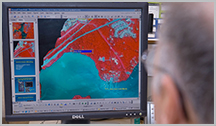Phases of ERA - Risk Characterization
Risk characterization

- Estimate ecological risks through integration of exposure and stressor-response profilesThe product of characterization of ecological effects in the analysis phase of ecological risk assessment. The stressor-response profile summarizes the data on the effects of a stressor and the relationship of the data to the assessment endpoint..
- Describe risk estimates in the context of the significance of any adverse effects and lines of evidence supporting their likelihood. Appendix E to the 1998 Guidelines for Ecological Risk Assessment (U.S. EPA, 1998) provides criteria for determining ecological adversity.
- Indicate the overall degree of confidence in the risk estimates. Summarize assumptions, scientific uncertainties, and strengths and limitations of the analyses.
Risk managers use risk assessment results, along with other factors (e.g., economic or legal concerns), in making risk management decisions and as a basis for communicating risks to interested parties and the general public. The Guidelines for Ecological Risk Assessment (U.S. EPA 1998) note that the interface among risk assessors, risk managers, and interested parties during planning at the beginning and communication of risk at the end of the risk assessment is critical to ensure that the results of the assessment can be used to support a management decision.
After completion of the risk assessment, risk managers may consider whether follow-up activities are required. They may decide on risk mitigation measures, and then develop a monitoring plan to determine whether the procedures reduced risk or whether ecological recovery is occurring. Managers may also elect to conduct another planned tier or iteration of the risk assessment if necessary to support a management decision.
Phase 3 of the ERA: Risk Characterization
Goal
Integrate exposure and stressor response profiles to evaluate the likelihood of adverse ecological effects associated with exposure to stressor(s) that includes discussion of lines of evidence and adversity of effects.
Who is involved?
Risk assessor(s), risk manager(s), and interested parties
Approach
- Estimate risks through integration of exposure and effects data and evaluation of any associated uncertainties. Use exposure and stressor-response profiles developed according to the analysis plan.
- Describe risks: Interpret risks based on assessment endpoints; evaluate lines of evidence to support or refute risk estimates in terms of adequacy and quality of data, degrees and types of uncertaintyUncertainty represents a lack of knowledge about factors affecting exposure or risk and can lead to inaccurate or biased estimates of exposure. The types of uncertainty include: scenario, parameter, and model., and relationship of evidence to risk assessment questions. Evaluate degrees of adversity given the nature of effects, intensity of effects, spatial and temporal scale, and potential for recovery.
- Describe uncertainties, assumptions, and strengths and limitations of the analyses.
- Synthesize overall conclusion about risk that will be used by risk managers in making risk management decisions.
Products
- Risk characterization report that:
- describes risk assessor/risk manager planning results;
- reviews the conceptual modelA conceptual model in problem formulation is written description and visual representation of predicted relationships between ecological entities and the stressors to which they may be exposed. and the assessment endpointsAn explicit expression of the environmental value to be protected, operationally defined as an ecological entity and its attributes.;
- discusses major data sources and analytical procedures used;
- reviews stressor-response and exposure profiles;
- summarizes risks to the assessment endpoints, including risk estimates and adversity evaluations; and
- reviews and summarizes major areas of uncertainty and approaches to address them.
Source: U.S. EPA 1998
The risk characterization phase within the overall ecological risk assessment process is illustrated below (adapted from U.S. EPA, 1998).

References
- U.S. EPA, 1998
- U.S. EPA, 2012
